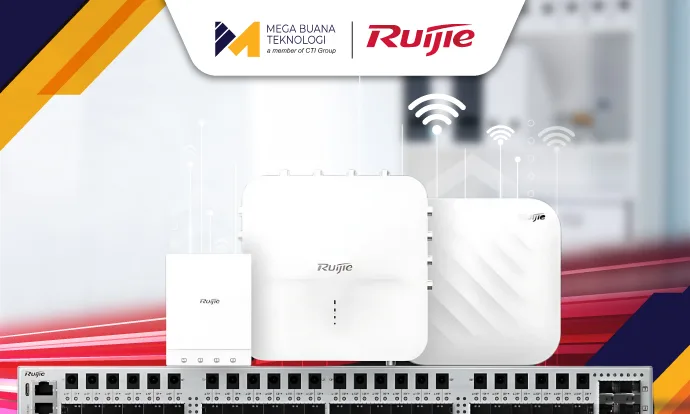Since its release this year, WiFi 7 has been claimed to be a new era of future internet connectivity. The latest generation of wireless networking technology promises much better speed and performance than its predecessor.
WiFi 7 is designed as a technology that is able to overcome the challenges of today’s WiFi networks, such as high data traffic density and the need for low latency. So, what exactly are the main features, advantages and innovations that WiFi 7 can offer? Here’s the full review.
What is WiFi 7?
WiFi 7 is a seventh-generation wireless networking technology based on the IEEE 802.11be standard which is the latest evolution of WiFi technology with significant improvements in network speed, efficiency, and capacity. With theoretical speeds of up to 23 Gbps or 4.8 times faster, WiFi 7 supports up to 320 MHz of bandwidth and 4K QAM modulation, making it almost five times faster than WiFi 6.
The technology is designed to meet the needs of future applications such as 8K video streaming, cloud gaming, and highly realistic VR and AR experiences, while providing superior performance in congested network conditions. Innovative features such as Multi-Link Operation (MLO), Multi-Resource Units (MRU) and Puncturing allow devices to connect to multiple frequencies simultaneously, providing a more stable connection and ultra-low latency.
Reliable networks are also supported by advanced technologies such as OFDMA (Orthogonal Frequency-Division Multiple Access) that improve the efficiency of data transmission in busy environments. With ultra-low latency and near-wired speeds, WiFi 7 is ideal for applications that require fast response times such as real-time video conferencing, online gaming, and IoT device control in the smart home.
History of WiFi Technology
If you look back, WiFi 7 is predicted to offer a number of advantages that its predecessor did not have. Here’s a brief history of WiFi technology from the first generation to the latest.
1997 – WiFi 1 (802.11): First came up with the 802.11 standard that offered data transfer speeds of up to 2 Mbps on a 2.4 GHz frequency signal.
1999 – WiFi 2 (802.11a): Significant increase in speeds up to 54 Mbps using a 5 GHz frequency signal. This frequency provides a faster connection, but with a shorter range than the 2.4 GHz frequency.
2002 – WiFi 3 (802.11g): Combines the speeds of WiFi 2 and WiFi 1 to provide greater flexibility for users with more compatible devices.
2009 – WiFi 4 (802.11n): Powered by MIMO (Multiple Input Multiple Output) technology and supports two frequencies, 2.4 GHz and 5 GHz capable of speeds of up to 600 Mbps. WiFi 4 marks a new era of stable and faster wireless networks.
2013 – WiFI 5 (802.11ac): Offers a huge leap at speeds up to 3.5 Gbps using a frequency of 5 GHz.
2019 – WiFi 6 (802.11ax): Offers high efficiency with speeds of up to 9.6 Gbps. Support for 2.4 GHz, 5 GHz, and 6 GHz (WiFi 6E) frequencies ensures optimal performance and compatibility, especially in environments with multiple connected devices.
2024 – WiFi 7 (802.11be): Significant improvements in efficiency, network capacity, and speeds of up to 46 Gbps. With ultra-low latency, WiFi 7 supports bandwidths up to 320 MHz as well as features 4K-QAM, Multi-Resource Units (MRUs), and Multi-Link Operation (MLO) for future application needs.
6 Key Features of WiFi 7
To provide superior performance, WiFi 7 is equipped with the following advanced features that make it a breakthrough in wireless network technology.
- Data transfer speeds are 40 percent higher or reach 46 Gbps compared to WiFi 6 thanks to MLO technology with a maximum bandwidth of 320 MHz and 4K-QAM support.
- Lower latency so devices can connect through multiple channels simultaneously, which is especially beneficial for gaming and real-time communication.
- Multi-device capabilities are improved thanks to improved efficiency of OFDMA (Orthogonal Frequency Division Multiple Access) and MU-MIMO technologies, allowing more devices to connect simultaneously without degrading network performance.
- Higher signal stability thanks to better interference mitigation methods for stable connections, even in network-dense environments such as in office buildings and public places
- Support for denser environments with Enhanced Channel Utilization technology support to work on non-continuous channels provides network flexibility to handle more users and devices at a time.
- Compatibility that supports devices with WiFi 6 and WiFi 5 standards, making the transition smoother for users with older devices.
What are the New Innovations of WiFi 7?
There are five main advantages of WiFi 7 compared to the previous generation.
- Speeds of up to more than 40 Gbps, or twice that of WiFi 6. Thanks to a data stream called Extremely High Throughput that results in fast performance for each access point.
- The latency is much lower so that the experience of 8K video streaming and online gaming is better.
- Compatible with previous WiFi standard-based devices making it possible for all devices to speed up the connection.
- More secure with WPA4 (WiFi Protected Access 4).
- More stable and faster thanks to Multi-Link Operation (MLO) technology that allows sending and receiving data simultaneously over different links.
Advantages of WiFi 7
With the ability to provide high speed and low latency, WiFi 7 provides a number of advantages over its predecessor:
- Ultra-high access speeds of up to 36 Gbps reduce reliance on wire connections.
- Better stability and connection resilience for many connected devices.
- AI integration to optimize network performance more efficiently.
- Compatible with a wide range of new devices and technologies that currently exist, making it easy to transition to new standards.
- Multi-Link Operation (MLO) capability with multiple channels at once to reduce latency and improve data transmission efficiency.
Benefits of Using WiFi 7
WiFi 7 is a game-changer thanks to its ability to combine high speed, low latency, and the ability to support a large number of devices. This technology can help businesses overcome barriers related to complex environments, including the use of IoT sensors in factories and real-time automation of low-latency production processes.
8K video streaming capabilities enable uninterrupted AI-based work and analysis processes. The cloud gaming experience and streaming high-resolution content has also become smoother. The ability to handle multiple devices simultaneously with a stable connection allows for seamless real-time monitoring.
To provide reliable connectivity solutions with low latency, Ruijie presents WiFi 7 intelligent solutions.
Ruijie Networks WiFi 7 Solutions: Leading the Way
Ruijie Networks delivers WiFi 7 solutions for all business and connectivity scenarios with cutting-edge wireless experience. Ruijie Networks’ WiFi 7 solutions can improve the access experience in high-density scenarios, while ensuring that the connection remains secure and stable.
WiFi 7 Ruiji Networks comes with two built-in AI radios for independent scanning on the 2.4 GHz and 5 GHz frequencies. This ensures a seamless roaming experience with an average
latency of less than 10ms for critical applications, such as video streaming and autonomous vehicles (AGVs).
Powered by digital twin-based Operation and Maintenance (O&M) technology, Ruijie offers a new wireless experience with higher speeds and lower latency on the long-lasting network of the future. This technology also supports telemetry-based data collection so that it can collect high-precision videos in seconds.
Twin-digit modeling enables real-time perception with the support of Big Data and AI to respond to changes in the network experience of each user. O&M in this case can localize visual errors for WiFi devices, optimize local networks, services, and VIP area networks. This can improve the efficiency and O&M experience of WiFi networks.
Ruijie WiFi 7 Solution Series
Ruijie Networks presents a series of WiFi 7 solutions to suit your business internet connection needs. Here are the specifications of some of the Ruijie WiFi 7 products.
RG-AP9861-R
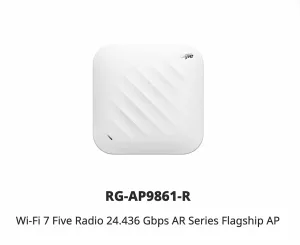
Source: Ruijie Networks
- Ruijie’s flagship Access Point series.
- WiFi 7 up to 24,436 Gbps
- Five radios: 2,4 GHz (4×4), 5 GHz 1 (4×4), 6 GHz (4×4), up to 18 spatial streams.
<h3>RG-AP9220</h3>
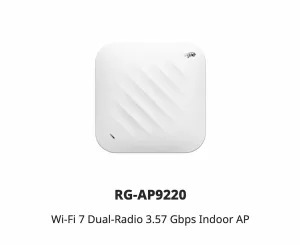
Source: Ruijie Networks
- WiFi 7 Dual-radio 3,57 Gbps
- Indoor Access Point
- Dual-radio: 2,4 GHz (2×2), 5G GHz (2×2), up to 4 spatial streams
RG-AP6920-D
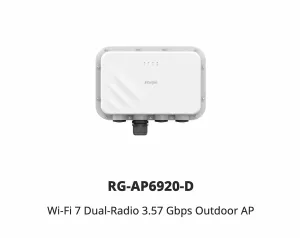
Source: Ruijie Networks
- WiFi 7 Dual-radio 3,57 Gbps
- Indoor Access Point
- Dual-radio: 2,4 GHz (2×2), 5G GHz (2×2), up to 4 spatial streams
RG-AP1920
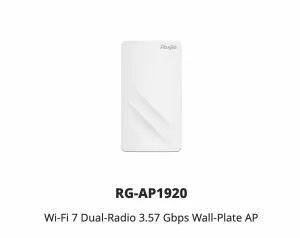
Source: Ruijie Networks
- WiFi 7 Dual-radio 3,57 Gbps
- Wall-plate Access Point
- Dual-radio: 2,4 GHz (2×2), 5G GHz (2×2), up to 4 spatial streams
RG-MAP920-SF-M
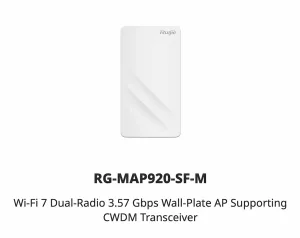
Source: Ruijie Networks
- WiFi 7 Dual-radio 3,57 Gbps
- Wall-plate Access Point supporting CWDM transceiver
- Dual-radio: 2,4 GHz (2×2), 5G GHz (2×2), up to 4 spatial streams
<h2>Get Ruijie WiFi 7 Solution on MBT</h2>
Mega Buana Technology, part of CTI Group, presents Ruijie Networks WiFi 7 as the best network solution with high speed and low latency. This solution is suitable for offices, industries, and public places by providing faster, stable, and secure connectivity.
MBT as an authorized distributor and partner of Ruijie ensures an optimal implementation process thanks to the support of a team of professional and certified engineers. It’s time to upgrade to WiFi 7 and experience unparalleled reliable network quality! Contact the MBT team by clicking this link.
Author: Ervina Anggraini – Content Writer CTI Group

